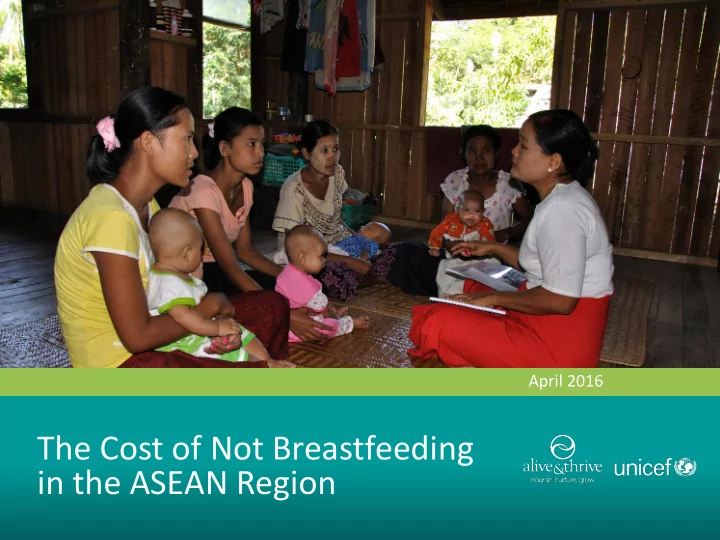

April 2016 The Cost of Not Breastfeeding in the ASEAN Region
Costs associated with inadequate breastfeeding Mortality Child: Excess mortality from diarrhea and pneumonia attributed to inadequate breastfeeding Maternal: Excess mortality from breast cancer since breastfeeding is protective Health system costs Excess costs for treatment for diarrhea and pneumonia Cognitive losses Inadequate breastfeeding impacts a child’s ability to learn and future earning potential Indirect costs Travel, caregiver time, and uninsured health care costs borne by households for diarrhea and pneumonia Formula Share of income in Southeast Asia spent on formula Alive & Thrive 2
Breastfeeding saves lives 50% 10% of child deaths (under two) of maternal deaths due to due to pneumonia and breast cancer could diarrhea could be be prevented annually prevented annually Alive & Thrive 3
Child and maternal deaths Annual lives lost 3,455 of 10,718 33,164 infants (<2 years of age) maternal deaths die annually from caused by breast pneumonia and diarrhea cancer could be due to inadequate averted if 90% of breastfeeding women breastfed for 5,570 deaths (<6 months) two years, instead of 5,148 deaths (6-23 1,749 deaths at months) current breastfeeding levels Alive & Thrive 4
Health care and cognitive savings Health care 293 Million USD costs could be saved by eliminating diarrhea and pneumonia due to inadequate breastfeeding (across all seven countries) Cognitive 1.6 Billion USD losses could be generated annually by improving breastfeeding and subsequently a child’s learning ability (across all seven countries) Alive & Thrive 5
Breastfeeding reduces indirect costs Families can incur additional lost work and transportation costs of up to 25% of the actual cost to treat diarrhea and pneumonia Alive & Thrive 6
Breastfeeding eliminates formula costs Up to 47% of a worker’s earnings would go to pay for economy brand formula (Families working in low-paid, formal sector jobs) Alive & Thrive 7
What must policymakers do to support breastfeeding? Alive & Thrive 8
Costs associated with inadequate breastfeeding Mortality 10,718 children and 1,706 additional mothers could be saved by moving from current levels to WHO-recommended levels Health system costs 293.55 million USD in health care expenses could be saved per year Indirect costs Eliminating indirect costs to treat diseases can save families significantly – up to 25% of the cost to treat diarrhea and pneumonia Formula Breastfeeding is free and can save families up to half of their monthly earnings by not having to purchase formula Cognitive losses Adequate breastfeeding could save nearly 1,630,200,000 USD in annual wage losses Alive & Thrive 9
Policies and programs that support breastfeeding International Code of Marketing of Breast-milk Substitutes • Enact and enforce legislation to restrict aggressive marketing of products that undermine breastfeeding Maternity protection • Allocate sufficient public funds for minimum six months paid maternity leave • Enact and enforce legislation that enables workplace lactation support and / or child care Alive & Thrive 10
Policies and programs that support breastfeeding Policies and practices in health facilities • Include nutrition counseling and the 10 Steps to Successful Breastfeeding in hospital standards and accreditation systems • Cover the costs for nutrition services by health financing schemes such as social and health insurance • Invest in pre- and in-service training curriculum for all healthcare providers Social and Behavior Change Communications • Communicate social and behavior change through multiple communication channels tailored to the local context, including through community networks and community-based workers Alive & Thrive 11
“Despite some progress, globally more than 800 million women workers (41%) do not have adequate maternity protection. Additionally, use of parental leave among men is low. We need maternity protection and work-family policies that are more inclusive and supportive of gender equality.” Guy Ryder, ILO Director-General, 2015 Alive & Thrive 12
This research was supported by Alive & Thrive, an initiative funded by the Bill & Melinda Gates Foundation and the governments of Canada and Ireland. The initiative is managed by FHI 360. We also acknowledge the support of Jack Bagriansky for sharing the methodologies and data from previous studies in Lao PDR, Timor-Leste and Cambodia (2013-2014), which were funded by UNICEF. This study also benefited from input provided by the Ministries of Health, Departments of Health and development partners in each country. Citation: Walters, D., S. Horton, A.Y.M. Siregar, P. Pitriyan, N. Hajeebhoy, R. Mathisen, P.T.H. Linh, C. Rudert. The Cost of Not Breastfeeding in Southeast Asia. Forthcoming 2016.
Recommend
More recommend